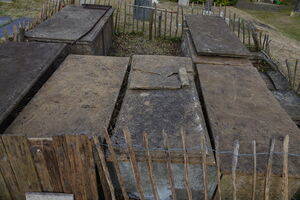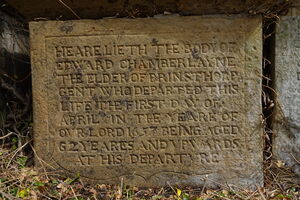- Profile
- Images
Location: Stretton upon Dunsmore, Warwickshire, England, United Kingdom
Surnames/tags: Chamberlayne Taylor Dry
Contents |
Information
The Burial Site

|
| [1] |

|
| Outline of Medieval Chapel |
Seven Grade II Listed box tombs comprise the Chamberlayne Burial Site - where, over 101 years, four generations of the Chamberlayne Family are buried, from Edward Chamberlayne of Princethorpe, Gent., (d. 1657), to his great grand-daughter, Bridgett (Chamberlayne) Taylor, (d. 1758). Six tombs are still intact - one (Elizabeth Chamberlayne, wife of William Chamberlayne of Princethorpe, Gent) is damaged and only pieces of the broken, inscribed grave slab remain. The tombs stand in a plot originally in the outside concave SE corner of what was the medieval chapel of All Saints, between nave and chancel (see 1820 sketch and diagram above.)
History of the Site
In the 1990s, Stretton upon Dunsmore Parish Council, concerned for the state of the site, tried, unsuccessfully, to contact some descendants. The site became overgrown with ivy, and eventually the graves were fenced off due to concern that their possible unstable condition could pose a danger to the public.

|
| Before the ivy was removed |
Recently
In August 2022, a small team of volunteers, two of them direct descendants of the Chamberlaynes, having gained permission from the church wardens, set to work to clear the ivy, which took two days. Significant amounts of vegetation were removed from the tombs using saws, secateurs and other garden equipment, in part purchased specifically for the task.
On 19 August, the tombs were finally clear and for the first time in over 30 years, the inscriptions could be read again.

|
| Chamberlayne Burial Site |
Who is buried here?
The Chamberlaynes buried here:
(For tomb position see corresponding numbers on diagram below).
- Edward Chamberlayne Esq., 'the Elder', Foedary and Escheator of Astley, and Princethorpe, Warwickshire
- Bridget (Hayle) Chamberlayne, wife of the above Edward
- Their eldest son, Edward, husband of Eleanor Cave
- Elizabeth, the wife of their second son, William Chamberlayne
- John Chamberlayne, their third son
- Edward Chamberlayne and
- His wife Jane Chamberlayne and
- Their two daughters, Mary (Chamberlayne) Dry and
- Bridgett (Chamberlayne) Taylor and possibly
- Edward, whose body was brought from London and buried on 24 Jun 1697,
- Jane, buried 11 Jan 1709,
- John, buried 11 May 1709, and
- Elizabeth, buried 11 January 1710.
These last four are probably buried here, since the inscription on Edward and Jane's tomb states that six of their children are buried nearby. Richard was buried in Hatfield Broad Oak, Essex. There is no indication as to what the children died of, but smallpox was rife at this time. [2][3]
One of the graves at the site, opposite that of Edward and Jane, (6 & 7) has lost all its inscriptions. Perhaps this contains the remains of the above four children. Or, it may be the grave of William Chamberlayne, (bur. 1683) before his wife Elizabeth, (4., bur. 1689). See diagram below.

|
| Diagram of Chamberlayne Burial Site |
Latest Information
According to latest information, the Parish Council intend to apply for a grant. They then intend to enlist the services of an archaeologist and surveyor, who will examine the site and recommend measures to appropriately protect and preserve it for posterity.
Further updates will be posted here.
Sources
- ↑ ed. William Page. The Victoria history of the county of Warwickshire. (Internet Archive Entry Uploader erroneously wrote, 'Sussex'). Knightlow Hundred. Vol. 6., (p.248.) Oxford University Press. Retrieved from the Internet Archive (Here;) Accessed 11 April 2024
- ↑ Appleby, Andrew, B., (1980)., Epidemics and Famine in the Little Ice Age. The Journal of Interdisciplinary History Vol. 10, No. 4, History and Climate: Interdisciplinary Explorations (Spring, 1980), pp. 643-663 (21 pages) Published by: The MIT Press. Retrieved from Jstor (Here;) Accessed 13 Sept 2022.
- ↑ Original bundle of correspondence between Charles Savage of London, merchant and William Savage, his brother, at Tachbrook, referring to domestic and financial matters. Retrieved from Warwickshire Past Unlocked (Here;) Accessed 13 Sept 2022.
Contact
For further information, contact: All Saints, Stretton on Dunsmore or the profile manager of this page.
Acknowledgements
Many thanks to Doug Hutchinson, Amanda and Alec Ross and to Gillian Forsythe of Stretton upon Dunsmore for their help and generosity, and to E. Chamberlayne for his saw!
Conservation of Historic Graveyards
- Conservation of Box Tomb Burial Sites. Retrieved from BC (Here;) Accessed 24 May 2023.
- O’Brien, Caimin, (September 2011, 2nd ed.) Guidance for the Care, Conservation and Recording of Historic Graveyards. The Heritage Council of Ireland with contributions from Mieke Muyllaert, Ecologist. ed.: Bernadette Guest Heritage Officer and Rosemary Ryall, Conservation Officer, Waterford County Council and Ian Doyle for the Heritage Council. Retrieved from hc ie (here;) Accessed 24 May 2023.
- Login to edit this profile and add images.
- Private Messages: Send a private message to the Profile Manager. (Best when privacy is an issue.)
- Public Comments: Login to post. (Best for messages specifically directed to those editing this profile. Limit 20 per day.)



